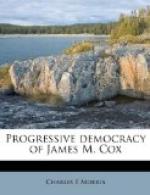CHAPTER VI
HOW HE HAS DEALT WITH INDUSTRIAL RELATIONS
The story of the result of Governor Cox’s treatment of industrial issues is told in his parallel of statements from Thomas J. Donnelly, Secretary of the Ohio Federation of Labor, and W. S. Thomas, a leading manufacturer.
Statement by Donnelly:
“Before Ohio had a Workmen’s Compensation Law, only twenty per cent of the injured workers, or the widows and children of deceased workers, were paid any compensation or damages. Eighty per cent got nothing whatever. When Cox was first elected governor, about five per cent of the workers of Ohio were covered under an optional Workmen’s Compensation Law. His first move as governor was to insist upon the passage of a Workmen’s Compensation Law that would benefit all the workers. In this he met with powerful and bitter opposition. But through his determined efforts the opposition was overcome and the law was passed. To-day the Ohio State Insurance Fund is the largest carrier of workmen’s compensation insurance, public or private, in the world. More than a million dollars a month is being collected by this fund, all of which is paid out for compensation and medical treatment for the injured workers or the dependents of those who are killed in the course of employment. This law supplied such an urgent need in the state that the employers and the laboring people of Ohio now look upon it as an accomplishment that outshines any other achievement in the state’s history.
“The report of the legislative agents of the Ohio State Federation of Labor show that fifty-six laws in behalf of laboring people were passed during Cox’s three terms as governor. Among these were laws forbidding the exploitation of women and children and limiting their hours of labor, providing for mothers’ pensions, providing for safety codes to protect life, limb and health and numerous other beneficent measures.”
Statement by Thomas:
“His strong sense of right and wrong, and the exercise of an unusual common sense, together with his frankness and courage in expression, have been the controlling factors in his successful relationship with the business interests of the state.
“A single example of his wisdom will illustrate this. For years organized labor and organized capital in Ohio have met during the sessions of the general assembly in what seemed to be a necessary antagonism. This was evidenced by the opposition of each to the proposed measures of the other. The result was ill feeling and little accomplished for either. It was Governor Cox’s suggestion that these organizations, represented by the State Federation of Labor and the Ohio Manufacturers’ Association, through their executive officers, should meet together and discuss pending legislation relating to the interest of either. Finally this plan was adopted, and it is the testimony of those participating




